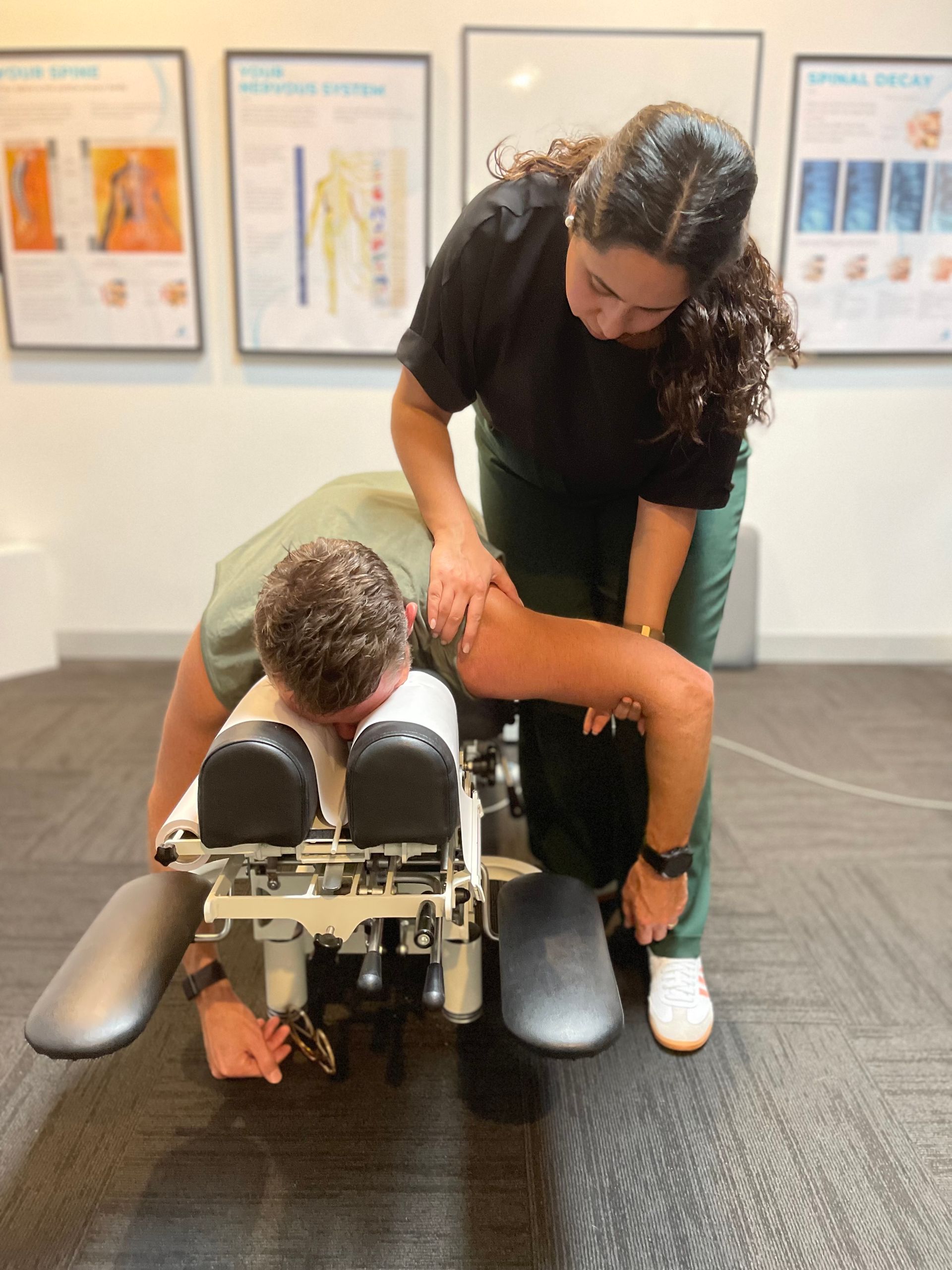When Should I See A Chiropractor Vs Physiotherapist
If ever you wonder if when should I see a chiropractor vs physiotherapist for pain or injury relief. Both professions offer similar services but use different methods, making it hard to choose.
This article will compare chiropractors and physiotherapists and suggest when to see each. I understand the importance of finding the right practitioner for your needs as someone who has always been fascinated by innovative healthcare.
Chiropractors treat musculoskeletal conditions by using spinal adjustments and manipulations to relieve pain and improve function. In contrast, physiotherapists use exercises, stretches, and manual therapy to promote healing and rehabilitation. We can better understand how chiropractors and physiotherapists can help us by studying their techniques. Knowing when to see a chiropractor versus a physiotherapist can help you recover from chronic back pain or a sports injury.
Join me as we explore these two healing paths in our search for innovative healthcare solutions.
When To See A Chiropractor
See a chiropractor if your chronic back pain hasn't responded to other treatments. Chiropractors diagnose and treat musculoskeletal disorders, especially spine disorders. They manually manipulate and adjust the spine to restore alignment and function.
Chiropractic care can relieve pain from injury, poor posture, and repetitive strain. A common condition chiropractors treat is neck pain. Long hours spent hunched over computers or phones cause neck pain for many. Chiropractic adjustments can achieve neck vertebrae realignment and muscle relaxation. Chiropractic care is holistic because it treats the cause of pain rather than just treating symptoms.
Noninvasive pain management methods include spinal decompression therapy and therapeutic exercises by chiropractors. These methods strengthen weak muscles, increase flexibility, and improve spinal health. Chiropractic treatments are natural and safe, unlike invasive procedures or medications.
When To See A Physiotherapist

A physiotherapist can help you recover from injuries and physical issues with customized treatment plans that empower and support you. Physiotherapists diagnose and treat many musculoskeletal conditions, relieving pain and improving function.
Whether you have acute or chronic pain, a physiotherapist can help you find the cause and create a treatment plan. Physiotherapy is effective for injury, illness, and surgery-related physical impairments. Physiotherapists use manual therapy, exercise prescriptions, and electrotherapy to reduce pain and inflammation and promote healing.
They can also teach you proper body mechanics and movement patterns to avoid injuries. Using their biomechanics knowledge, physiotherapists can help you strengthen weak muscles and regain balance.
Physiotherapists manage chronic pain as well as injuries and conditions. They treat patients holistically, considering physical, psychological, and social factors that may cause pain. They teach patients how to manage their symptoms through education, counseling, and various therapies.
Before discussing 'physiotherapy techniques,' it's important to note that physiotherapy offers many treatment options to improve mobility, function, and quality of life. Physiotherapists use many techniques, from joint mobilization and soft tissue release to ultrasound and laser therapy. Physiotherapists tailor these techniques to each patient's condition and goals.
You can take charge of your recovery and physical health by seeing a physiotherapist. They will treat your symptoms and teach you how to avoid injuries. Consult a physiotherapist if you're in pain or have other physical impairments. They can help you recover.
Physiotherapy Techniques
A wide range of physiotherapy treatments can improve mobility, function, and quality of life, making your recovery more personalized and effective. Physiotherapists receive extensive training in musculoskeletal conditions and treatment methods.
Manual therapy, such as joint mobilization or manipulation, can relieve pain and restore movement. In addition to manual therapy, physiotherapists use customized exercises and therapeutic activities. This may involve strengthening weak muscles, increasing flexibility, or improving balance and coordination. Physiotherapy treats these root causes to relieve symptoms and prevent future injuries.
Physiotherapists also use ultrasounds and electrical stimulation. These technologies can target pain and promote tissue healing by increasing blood flow or reducing inflammation. New research and evidence-based practice drive physiotherapy innovation.
In the next section about chiropractic techniques, we'll see that both physiotherapists and chiropractors can treat musculoskeletal conditions, but they use different methods. Chiropractic techniques focus on joint adjustments to realign the spine and other joints. In contrast, physiotherapy offers more than joint adjustments.
Chiropractic Techniques

Chiropractic techniques use customized adjustments to optimize joint alignment and function. Chiropractors use noninvasive joint function restoration methods to treat pain and physical impairments. These methods manually manipulate the spine and other joints to relieve pain, improve mobility, and boost well-being.
Spinal manipulation, or adjustment, is a common chiropractic technique. Chiropractors realign misaligned or restricted vertebrae with controlled force. This technique reduces nerve pressure, reduces pain, and speeds healing. Chiropractors can also use mobility techniques to reduce stiffness by gently moving joints through their natural range of motion.
Chiropractors use manual pressure or instruments to treat muscle tension or adhesions in the soft tissues around the joints. This involves treating muscle tension or adhesions in soft tissues around joints with manual pressure or instruments. Chiropractors can reduce pain and improve joint function by targeting tightness or inflammation.
Chiropractic treatments may also include lifestyle advice, exercise, and ergonomic changes to prevent injury or manage chronic conditions. By treating the root causes of physical impairments and providing holistic care, chiropractors aim to improve long-term health.
Differentiating Between Chiropractors And Physiotherapists
Understanding the differences between chiropractors and physiotherapists is essential for personalized pain and physical impairment management.
Both professions improve movement and function, but in different ways. While chiropractors use manual adjustments to restore spinal function, physiotherapists use noninvasive methods to treat various physical impairments.
Chiropractors specialize in spinal manipulation. They believe spine misalignments cause pain and hinder healing. Chiropractors use controlled force to correct spine misalignments and improve health. Back, neck, and headache pain often improve with this hands-on approach.
However, physiotherapists treat physical impairments holistically. These treatments address both symptoms and the root causes of dysfunction or injury. Physical therapy may include exercises, stretches, ultrasound, heat or cold therapy, and electrical stimulation. These treatments aim to improve mobility, pain, and healing.
Chiropractic care focuses on spinal adjustments, but physiotherapy offers a wider range of personalized interventions. Physiotherapists work with patients to create personalized exercise programs that target muscle imbalances or weaknesses. They also teach posture and mechanics to prevent injuries.
These differences between chiropractors and physiotherapists can help you choose the right healthcare professional.
In the next section about the benefits of physiotherapy, we will discuss how evidence-based techniques can complement traditional medical treatments and provide long-term pain relief without manual adjustments.
Benefits Of Physiotherapy

Physiotherapy provides a holistic approach to pain management and mobility by using a variety of noninvasive techniques to treat physical impairments.
Physiotherapy treats body impairments, unlike chiropractic care, which focuses on spinal adjustments. Physiotherapists use noninvasive methods to treat musculoskeletal injuries, post-operative rehabilitation, and chronic conditions like arthritis.
Physiotherapy manages pain and other symptoms noninvasively, which is a major benefit. Physiotherapists treat pain and improve function with manual therapy, exercise, electrotherapy, and education. Physiotherapy treats the causes of pain rather than just masking it, providing long-term relief for acute and chronic conditions.
Mobility is another benefit of physiotherapy, besides pain management. Physiotherapists collaborate with patients to create customized treatment plans that address specific issues. They improve strength, flexibility, and movement patterns with targeted exercises and stretches. Addressing imbalances and weaknesses improves mobility and prevents future injuries.
Benefits Of Chiropractic Care
Discover chiropractic care's life-changing benefits for your health. Focusing on the spine-nervous system relationship, chiropractic care is unique. Chiropractors use manual adjustments to realign and function the spine, which can improve your health.
You can expect many benefits from chiropractic care. Chiropractic adjustments relieve musculoskeletal pain first. Chiropractors can diagnose and treat back, neck, and headache pain. Gentle spinal manipulations relieve nerve pressure and improve joint mobility, reducing pain and improving functionality.
Second, chiropractic care boosts your body's natural healing capacity, promoting wellness. By realigning the spine and removing nervous system interference, chiropractors improve brain-body communication. Improved communication boosts immune function, organ function, energy, and vitality.
Besides physical benefits, chiropractic care addresses mental health issues. Stress, anxiety, and depression often accompany chronic pain. Chiropractic adjustments reduce chronic pain and psychological symptoms. Chiropractic care, regularly scheduled weeks or months apart, depending on severity, restores balance in your body's structure and nervous system, reducing emotional distress and restoring control over your life!
Chiropractic care's pain relief, muscle tension reduction, stress management, and sleep quality benefits will show you how this holistic approach can improve your health. After discussing the many benefits of physiotherapy and chiropractic care, let's compare their main differences.
Choosing Between Chiropractic And Physiotherapy

Chiropractic care has many benefits for pain relief and overall health, as we discussed earlier. Chiropractic care isn't the only way to treat musculo-skeletal issues. Physiotherapists may be better in some cases.
When should I see a chiropractor vs physiotherapist? Explore this topic further.
The nature of your condition and treatment goals should determine whether you see a chiropractor or physiotherapist. Spinal manipulation and adjustments are chiropractors' main treatments for nerve function and alignment. Physiotherapists use exercise, manual therapy, and electrotherapy to treat injuries and improve mobility.
Both professions aim to relieve pain and restore function, but their methods vary. A chiropractor may perform spinal adjustments to relieve acute back pain after an injury or accident. A physiotherapist may be better able to create a personalized rehabilitation program for you if you're recovering from surgery or have chronic pain from arthritis or fibromyalgia.
Your treatment preferences are another factor. If you prefer hands-on manipulation and fast results, see a chiropractor. If you prefer an approach that uses various exercises and techniques to strengthen muscles and improve flexibility, a physiotherapist may be best.
Choosing between a chiropractor and a physiotherapist depends on your condition, treatment goals, and treatment preferences. Chiropractors focus on spinal adjustments and nerve function, while physiotherapists use multiple methods to treat injuries and improve mobility. Understanding the differences between these two professions helps you choose a healthcare provider.
Common Injuries Treated By Physiotherapists
Physiotherapists can safely and effectively treat injuries to help you regain strength and mobility. Rehabilitation with physiotherapy can treat many common injuries. Three common injuries treated by physiotherapists:
- Sprained Ankles: Whether you've twisted your ankle during sports or simply stumbled on uneven ground, sprained ankles are a frequent occurrence. Physiotherapists have techniques to reduce pain and swelling, while also improving stability and range of motion through exercises and manual therapy.
- Shoulder Impingement: This painful condition often occurs due to repetitive overhead movements or poor posture. A physiotherapist will assess your shoulder function and develop an individualized treatment plan involving specific exercises to strengthen the muscles around the shoulder joint, improve posture, and alleviate pain.
- Lower Back Pain: One of the most prevalent musculoskeletal issues, lower back pain can be debilitating. Physiotherapists employ various methods such as spinal mobilization, core stabilization exercises, and postural correction strategies to relieve pain, restore flexibility, and enhance overall function.
By treating these common injuries with customized physiotherapy, you can improve your physical health. These treatments relieve symptoms and rehab the affected area for long-term recovery.
Common Injuries Treated By Chiropractors

Want to learn how chiropractors can treat common injuries? A chiropractor specializes in diagnosing and treating musculoskeletal disorders, especially spine disorders. They manipulate body alignment and promote natural healing with hands-on techniques.
While physiotherapists treat common injuries, chiropractors may benefit some conditions with their unique approach.
Lower back pain is a common chiropractic injury. Poor posture, muscle strain, or herniated discs can cause this. To determine the cause of your pain, chiropractors will examine you and possibly take X-rays. They will realign your spine, relieve pressure, and reduce inflammation with spinal adjustments or manipulations. Chiropractors relieve lower back pain and improve mobility by restoring spine function.
Car accident whiplash and poor work ergonomics can cause neck pain, which chiropractors treat. Car accident whiplash or poor work ergonomics can cause debilitating neck pain. Chiropractic neck pain treatment often involves gentle cervical spine adjustments to relieve tension and restore range of motion. These adjustments may also increase blood flow to the affected area, speeding healing.
Sports injuries are another specialty of chiropractors. They understand how repetitive movements and impacts affect body alignment and function, from sprained ankles to tennis elbows. Chiropractors can help athletes recover and prevent injuries with targeted adjustments and exercises.
Health Insurance Coverage For Chiropractic Care
People seek chiropractors for their expertise in treating common injuries. Back, neck, and headache pain are among their specialties. Their treatment involves spinal manipulations and adjustments to relieve symptoms and promote healing.
Before getting chiropractic care, check your health insurance. Health insurance coverage for chiropractic care varies by provider and plan. Some health insurance plans limit coverage or require a primary care physician referral before seeing a chiropractor. Review your policy or contact your insurance company to learn what services are covered and if there are any restrictions.
Chiropractic care can treat some conditions better than conventional medicine. Regular chiropractic visits relieve chronic pain for many. Physiotherapy may be an alternative to chiropractic care if your health insurance does not cover it or has significant limitations.
Physiotherapists treat musculoskeletal injuries and conditions differently than chiropractors. They use exercises, manual therapy, and other methods to improve mobility, strength, and function. Health insurance covers physiotherapy with fewer restrictions compared to chiropractic.
Health Insurance Coverage For Physiotherapy

Your insurance may cover physiotherapy, a non-invasive and effective treatment for musculoskeletal injuries. Physiotherapy helps injured or surgical patients move and function again. It uses manual therapy, exercises, and electrical modalities.
If your health insurance covers physiotherapy, you may experience three benefits:
- Pain Relief: Physiotherapists are trained to assess and treat pain caused by musculoskeletal injuries. They can use techniques like joint mobilization, soft tissue massage, and therapeutic exercises to alleviate pain and improve mobility.
- Improved Function: Whether you're recovering from a sports injury or trying to regain function after surgery, physiotherapy can help improve your overall physical functioning. Through targeted exercises and rehabilitation programs, physiotherapists can help restore strength, flexibility, balance, and coordination.
- Preventive Care: Physiotherapy isn't just about treating existing injuries; it also focuses on preventing future ones. By addressing underlying issues like muscle imbalances or poor posture, physiotherapists can help reduce the risk of recurring injuries in the long run.
Health insurance plans and providers cover physiotherapy differently. Some plans limit sessions to one per year or require prior authorization. Contact your insurance company to determine your coverage.
Physical Therapist Vs. Chiropractor: Which Is Right for You?
Looking for the right musculoskeletal treatment? Let's compare physical therapists and chiropractors so you can choose the right one. Both professionals manage pain and injuries, but their methods and specialties differ.
Chiropractors diagnose and treat spine, joint, and nervous system conditions. They manipulate the spine and other body parts manually. Chiropractors can help with back pain and other spinal issues. Targeted treatments can reduce pain and improve mobility.
Physical therapists specialize in rehabilitation and functional improvement. Exercises, stretching, and other therapies improve strength, flexibility, balance, and range of motion. Physical therapists help injured or surgical patients regain function. Physiotherapy may be best for pain relief and long-term recovery.
Each case is unique; what works for one may not work for another. Consider your condition and treatment goals when choosing a professional. Consulting with a chiropractor and physiotherapist can help you find personalized treatment options. Let's use chiropractic to treat pain and injury while considering these factors.
Managing Pain And Injury With Chiropractic Care

Imagine a skilled chiropractor manipulating your spine and joints to restore alignment and mobility and relieve your pain and injury. Chiropractic pain management is novel and focuses on the musculoskeletal system.
A chiropractor can help you heal from chronic back pain or a sports injury. Chiropractors can pinpoint the source of your pain, which is a major benefit. A thorough evaluation will determine the cause of your pain before creating a customized treatment plan. Chiropractors provide long-term relief by treating the cause, not the symptoms.
Non-invasive chiropractic treatments for pain and injury are also available. Chiropractors use manual adjustments to restore balance instead of medication or surgery. Without medication, these gentle manipulations can improve joint function, reduce inflammation, and promote natural healing.
Chiropractors may use soft tissue therapy and rehabilitative exercises in addition to spinal adjustments. Chiropractic treatments include soft tissue therapy and rehabilitative exercises to address all aspects of your condition for optimal recovery. For pain and injury management, consult a chiropractor with expertise.
Managing Pain And Injury With Physiotherapy
Physiotherapy is a non-invasive, effective treatment for pain and injury. Unlike chiropractic care, which focuses on spinal adjustments, physiotherapy treats pain and injuries holistically.
Physiotherapy can help you recover from lower back pain or sports injuries. Lower back pain patients benefit from physiotherapy. Physiotherapists can target lower back pain with manual therapy, exercise, and posture and body mechanics education. They will help you find the cause of your pain and create a customized plan.
In addition to lower back pain, physiotherapy can treat other injuries. Physiotherapists can diagnose and treat injuries like sprained ankles and muscles. Range of motion, strengthening, and hands-on techniques like massage or joint mobilization may be used. The focus on long-term management and symptom relief makes physiotherapy a better choice than chiropractic care.
Physiotherapists will help you recover quickly and prevent future injuries. They will teach you proper body mechanics for daily activities and sports to keep you healthy. Physiotherapy can help manage pain and injuries, like lower back pain. Manual therapies, personalized exercise programs, and long-term management strategies give patients lasting relief and improve their health. If you're in pain or injured, a physiotherapist can help you recover.
Final Thoughts
In conclusion, when deciding when should I see a chiropractor vs physiotherapist, it's important to consider your specific needs and preferences. If you're seeking treatment for musculoskeletal issues such as back pain or joint stiffness, a chiropractor may be the right choice for you. Chiropractic techniques focus on spinal adjustments and manipulation to promote alignment and relieve pain.
On the other hand, if you're looking for a more comprehensive approach that includes exercises, stretches, and hands-on therapy, physiotherapy may be the better option. Physiotherapists use various techniques such as massage, ultrasound therapy, and electrotherapy to treat injuries and improve mobility.
Ultimately, both chiropractors and physiotherapists can provide effective treatment for a range of conditions. It's essential to consult with professionals in each field to determine which approach aligns best with your goals and preferences.
Remember to check your health insurance coverage as well to ensure that any treatments you receive are covered. Whether you choose chiropractic care or physiotherapy, both can help manage pain and injury effectively so that you can get back to living an active and healthy life.
Frequently Asked Questions
Can A Chiropractor Or Physiotherapist Help With Chronic Pain Conditions?
Yes, chiropractors and physiotherapists treat chronic pain. I understand the need for innovative pain relief solutions because I've had chronic pain. Misalignments or imbalances cause pain relief through chiropractic manipulation of the spine and musculoskeletal system.
However, physiotherapists use exercises, stretches, manual therapy, and electrical modalities to improve mobility, strength, and flexibility and reduce pain.
Instead of treating symptoms with medication, both professions treat the cause of your pain. Your condition and preferences determine whether you choose a chiropractor or physiotherapist. Always consult with both professionals to see which approach best suits your innovative healing and long-term pain management goals.
Are There Any Risks Or Side Effects Associated With Chiropractic Care Or Physiotherapy?
Chiropractic and physiotherapy have risks and side effects. Some chiropractic patients experience temporary soreness or discomfort after adjustments. Complex complications, like fractures or nerve damage, are rare.
Physiotherapy risks include muscle soreness or fatigue from exercises and injury exacerbations if not properly managed. However, chiropractors and physiotherapists receive extensive training to reduce these risks and ensure patient safety. Before starting any treatment, discuss any concerns or side effects with your doctor.
How Long Does It Typically Take To See Results From Chiropractic Treatment Or Physiotherapy?
The length of time it takes for chiropractic or physiotherapy to work depends on your condition, health, and compliance with the treatment plan. I've found that pain and mobility symptoms improve after a few sessions. Remember that chiropractic and physiotherapy focus on long-term healing, not short-term fixes. Therefore, patience and commitment are essential for success.
These fields are constantly evolving, so new methods and approaches may improve results. If you want innovative health solutions, a chiropractor or physiotherapist may be a good fit.
Can Chiropractors Or Physiotherapists Help With Sports-Related Injuries?
Chiropractors and physiotherapists can treat sports injuries. My athletic background has taught me the importance of staying fit and recovering quickly from injuries.
Chiropractors use manual adjustments and spinal manipulations to treat musculoskeletal issues such as misalignments and joint dysfunctions. They can reduce pain, improve mobility, and speed healing.
Physiotherapists use ultrasound, electrical stimulation, and exercise programs to treat injuries. They relieve pain and inflammation and restore strength. Both chiropractors and physiotherapists treat sports injuries differently, so it depends on the athlete's needs and preferences. Their expertise can help you recover faster from sports injuries and reach your athletic goals.
Is Chiropractic Care Or Physiotherapy Covered By Health Insurance?
Check your policy or contact your insurer to see if these services are covered. Check your policy or contact your insurance provider to see if chiropractic and physiotherapy are covered.
Chiropractic care targets musculoskeletal issues with spinal adjustments and manipulations, while physiotherapy improves mobility, strength, and function with a wider range of treatments. Your condition or injury must be considered when choosing between the two. Chiropractors and physiotherapists treat sports injuries well. Chiropractors focus on spinal alignment and joint mobilization, while physiotherapists use exercises and other modalities.
Finally, talking to both professionals or getting a referral from your primary care provider can help you choose the right approach.
Latest Articles
Mornington Peninsula
Chiropractic
Just up the road from you...
- Mon - Fri
- -
- Sat - Sun
- Appointment Only
Mornington
03 9787 8518
Rosebud
03 5911 8181
CONDITIONS
LINKS
Our Locations
Designed By Jon Web Design



